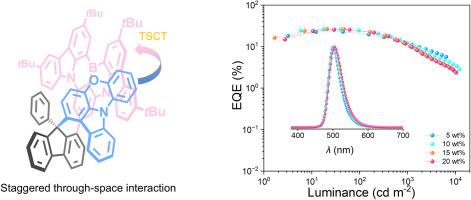交错通过空间相互作用实现了多共振TADF发射极的杂化局部和电荷转移调节
IF 4.2
3区 工程技术
Q2 CHEMISTRY, APPLIED
引用次数: 0
摘要
硼/氮基多共振热激活延迟荧光(MR-TADF)材料具有窄带发射效率高的特点,但其性能经常受到低效的反向系统间交叉(RISC)和激子猝灭的影响。在这里,我们提出了BNCz-IPXZ,一种新的MR- tadf发射极,在刚性MR受体(BNCz)和平面吲哚[3,2,1-kl]苯恶嗪(IPXZ)供体之间具有交错的空间相互作用。这种交错的面对面排列诱导了杂化的局域激发态和电荷转移激发态特征,显著增强了自旋翻转,RISC速率为8.21 × 104 s−1。刚性磁流变核和平面给体的集成也限制了结构弛豫和抑制非辐射衰变,导致窄带发射和高达92%的高光致发光量子产率。结合BNCz-IPXZ的有机发光二极管表现出窄带绿色电致发光,峰值外量子效率为32.1%,半峰全宽度为40 nm。这些发现证明了一种合理的设计方法,可以通过交错穿越空间的HLCT工程实现高效的窄带MR-TADF发射器。本文章由计算机程序翻译,如有差异,请以英文原文为准。

Staggered through-space interaction enables hybridized local and charge-transfer regulation for multi-resonance TADF emitter
Boron/nitrogen-based multi-resonance thermally activated delayed fluorescence (MR-TADF) materials offer narrowband emission with high efficiency, but their performance is often hindered by inefficient reverse intersystem crossing (RISC) and exciton quenching. Herein, we present BNCz-IPXZ, a new MR-TADF emitter featuring a staggered through-space interaction between a rigid MR acceptor (BNCz) and a planar indolo[3,2,1-kl]phenoxazine (IPXZ) donor. This staggered face-to-face arrangement induces a hybridized local and charge-transfer excited state character, significantly enhancing spin-flipping with a RISC rate of 8.21 × 104 s−1. The integration of a rigid MR core and planar donor also restricts structural relaxation and suppresses nonradiative decay, resulting in narrowband emission and a high photoluminescence quantum yield of up to 92 %. Organic light-emitting diodes incorporating BNCz-IPXZ exhibit narrowband green electroluminescence with a peak external quantum efficiency of 32.1 % and a full width at half maximum of 40 nm. These findings demonstrate a rational design approach for achieving efficient, narrowband MR-TADF emitters through staggered through-space HLCT engineering.
求助全文
通过发布文献求助,成功后即可免费获取论文全文。
去求助
来源期刊

Dyes and Pigments
工程技术-材料科学:纺织
CiteScore
8.20
自引率
13.30%
发文量
933
审稿时长
33 days
期刊介绍:
Dyes and Pigments covers the scientific and technical aspects of the chemistry and physics of dyes, pigments and their intermediates. Emphasis is placed on the properties of the colouring matters themselves rather than on their applications or the system in which they may be applied.
Thus the journal accepts research and review papers on the synthesis of dyes, pigments and intermediates, their physical or chemical properties, e.g. spectroscopic, surface, solution or solid state characteristics, the physical aspects of their preparation, e.g. precipitation, nucleation and growth, crystal formation, liquid crystalline characteristics, their photochemical, ecological or biological properties and the relationship between colour and chemical constitution. However, papers are considered which deal with the more fundamental aspects of colourant application and of the interactions of colourants with substrates or media.
The journal will interest a wide variety of workers in a range of disciplines whose work involves dyes, pigments and their intermediates, and provides a platform for investigators with common interests but diverse fields of activity such as cosmetics, reprographics, dye and pigment synthesis, medical research, polymers, etc.
 求助内容:
求助内容: 应助结果提醒方式:
应助结果提醒方式:


